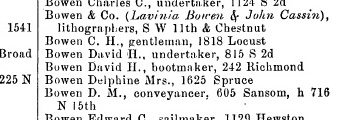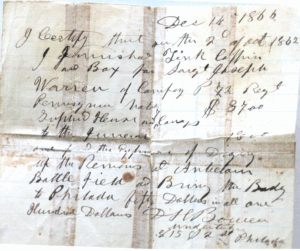Sgt Warren returned to Philadelphia
11 September 2025
Sergeant Joseph Warren of Company P, 72nd Pennsylvania Infantry was killed at Antietam on 17 September 1862, probably in the furious combat in the West Woods there that morning. He was originally buried by his mates on the field, but his remains were returned home to his family in October.
This extraordinary document was kindly shared by descendant Mark Warren from the collection of his father George Cletus Warren Sr.
Notes
My transcription:
Dec 14 1866
I certify that on the 2d of Oct 1862 I furnished Zink (Zinc) Coffin and Box for Sargt Joseph Warren of Company P 72 Regt Pennsylvania Vols
$87.00
Supplied Hearse and 7 [C__s?] to the funeral 18.00
and for [___] the Purpose of Digging up the Remains at Antietam Battle field and Bring the Body to Philada [Philadelphia] fifty dollars. in all one Hundred Dollars.
D H Bowen
undertaker
815 S 2 St Philada
The author was David Hand Bowen (9 July 1813 – 27 January 1903).
Here’s Bowen’s entry from page 92 of McElroy’s Philadelphia City Directory for 1866, which is online from the Greater Philadelphia GeoHistory Network:

Participant #23,000: Clay Esshom
29 August 2025
We’ve just passed another milestone in the collection of Campaign participants at Antietam on the Web – now over 23,000 individuals in the database.
#23,000 is Private Clay Esshom of Company A, 14th Indiana Infantry, who survived a fearful gunshot through his body in combat at Antietam on 17 September 1862 – then a month shy of his 20th birthday. He was afterward a successful farmer and stockman near his boyhood home in Monroe County, Iowa to his death at age 59 in 1902.
Here’s his simple stone in Lovilia, IA; Findagrave photo thanks to the late Pat Kiser.
First Sergeant W.H. Andrews at Sharpsburg
30 July 2025
Our rations were out Sunday. Monday and Tuesday we had nothing but water …
Just about sunset, a cow came feeding in front of our lines. Gen. [G.T.] Anderson ordered her killed and divided among the brigade. Soon had my little piece broiled over the coals, and ate it with the blood running out, without either salt or bread. Just whetted my appetite with nothing more to be had. How long, oh how long before we get something to eat? While we are all so hungry you don’t hear any complaints among the men, all knowing that rations are not to be had, being so far from our line of communication, all of our supplies coming from Virginia. No foraging allowed by Gen. Lee on the enemy’s country. What a contrast between our invasion and that of the enemy, who take everything as they go.
– William H Andrews, First Sergeant, Company M, First Georgia Infantry (Regulars) at Sharpsburg on Tuesday, 16 September 1862
Here’s Sergeant Andrews many years later, probably as he looked as he wrote his memoirs, source of the quote above.

Notes
Thanks to Kevin Whitehead for sharing the photo of his 3x great-grandfather and for the lead to William’s memoirs. They were published in Footprints of a Regiment: a Recollection of the 1st Georgia Regulars, 1861-1865 (1992), edits and notes by Richard M. McMurry.


